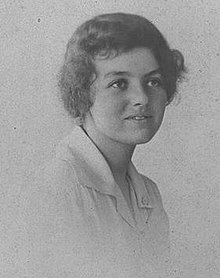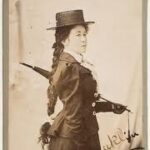by Jean Curlewis (1898-1930)
A maiden lady discovers a cure for loneliness.
At the post-office Miss Eldridge felt suddenly even more lonely than usual.
She collected the magazine which constituted her entire mail, and turned wistfully away from the little social gathering that mail-time always occasioned in Goolabah. An absurd desire came ever her to be young enough to wear a cherry-coloured tennis scarf like the girl who got so many letters; she wished she could have changed places with Mrs. Ellis hurrying home, because she had a noisy family of seven for which to provide dinner; she wished she could stroke small Jock Keane’s round head (she had kissed him once, and he had distrusted her ever since); she wished, in short, she were anyone but Miss Eldridge, maiden lady, lately come to Goolabah merely because one must live somewhere, and the inland air was good for her asthma.
Even her studio and her sketches, and her faithful copies of famous pictures brought her no solace this evening. Mechanically she turned the leaves of her new arrived magazine, “The Artist.”
And then a picture blazed out of the pages at her!
* * * * * *
It was three months later—three months during which Miss Eldridge, rapt, absorbed, happy, had been copying on an immense scale a reproduction in “The Artist.” Copying was an art in which her painstaking brush had always excelled, and yet what new thing was it that now lent such passionate delight to this curious subject? Was it reaction after years of repression—or some streak of heredity—or something that dated back to the days when she played with a schoolboy brother?
Miss Eldridge did not know—it is only certain that when the Ladies’ Art Society of Goolabah invited her to exhibit at its display she did not even glance at her delicate landscape studies. Though its paint was hardly dry, she despatched her new canvas.
And now it was opening day, and Goolabah was gazing with doubtful eyes. Miss Eldridge’s ears caught occasional murmurs where the words “crude,” “a little garish, don’t you think?” seemed to predominate. “Such a pity she didn’t send one of her flower panels,” sighed the secretary.
After which the matrons of Goolabah drifted relievedly on to a still-life study of lemons, by “dear Vida, who has only had ten lessons—not another minute. But, of course, it was always in our family—.”
Miss Eldridge went home early, suddenly tired, and lonely again. At her gate she discovered she had forgotten her umbrella, and went back.
“Everyone has gone,” said the girl at the door, “except for ten small boys, who rushed in after Jock Keane in great excitement just now. I wonder what the attraction is? Can’t imagine them paying whole sixpences merely for the sake of art.”
Miss Eldridge went in, not at all interested.
Then she caught her breath! The end of the room was crowded with small boys with upturned faces, gazing hungrily, thirstily, at her picture!
Such a canvas it was—veritably shouting of sun, and wind, and salt, and colour!
It was a sand dune against a brilliant blue surf. On the dune, startlingly life-size, startlingly alive, sat three great pirates. Scarlet bandanas bound their heads, their shirts rolled back from sun-blackened throats, shorts left bare the brawny legs, earrings like hoops swung at their ears.
And sprawling down the sand hill from their feet was flung the body of another pirate, a gash across its throat scarlet as the bandanas, its stiffening, clawing fingers still full of sand, clutched in the death agony.
Between two of the living buccaneers there was a pile of treasure—the third, who gazed out of the picture with narrowed eyes, was cleaning a cutlass blade between his fingers—a blade that dripped red on to the white sand. And one seemed to feel the heat and hear the screaming seabirds overhead.
Miss Eldridge hesitated behind the boys. There was a long hush—the hush that is due of genius.
Then
“Str-r-ruth,” said little Peter Gales, in awed content.
Whereupon the meeting, feeling that its feelings had thereby been adequately expressed, burst into excited babble.
Jock’s proud voice piped high above it.
“It was Miss Eldridge painted it,” he said. “I know her. She gave me some chocolate once. I know her quite well.”
The boys regarded him enviously.
“Did she have real pirates for models?” inquired Peter.
An idea flashed on Miss Eldridge. She stepped forward amongst them.
“Not real pirates, I’m afraid,” she said, “but she did have a real cutlass. My grandfather bought it in the Indies. Would you core to come and see it someday?”
The meeting did not answer. It merely took a simultaneous step towards the door.
“Not to-day ” said Miss Eldridge, planning rapidly. “Friday, at 4.”
* * * * * *
It was Friday. At five to 4. Her preparations were complete. A flying visit to town to collect the properties, and the studio was transformed. Where the cretonne divan had been stood a tarry sea-chest, furnished like that famous chest of Billy Bones in “Treasure Island,” which began with “a sextant and two brace of handsome pistols,” and ended with a certain magic chart. On the bookcase “Treasure Island” itself waited to be read aloud. On the wall, in place of the Winged Victory, hung the cutlass; on the table was fruit cup in battered tankards.
“I shall call it rum punch,” whispered Miss Eldridge happily.
“You see,” she explained to the old figure-head she had discovered in a timber-yard, and which, she thought, seemed to blame her occasionally for such extravagance over childish games, “There isn’t any picture show in the town, and they have such a dull time, and—and, anyway, it’s my own money, and I shall spend it as I like.”
Then her face fell. “I haven’t got a parrot,” she said, “to say ‘Pieces of Eight’.”
It was 4 o’clock. Outside came the tramp of many small and sturdy feet. Evidently the number of guests had increased. Trembling with excitement, the no longer lonely Miss Eldridge drew back the door—
~
Curlewis, Jean, The lonely lady, The Australasian, 28 Aug 1920: 57.
Image by Katherine Elder, Mosman; source: https://www.pittwateronlinenews.com/jean-curlewis-history.php accessed 14/11/2023, from the National Library of Australia collection.






Trackbacks/Pingbacks